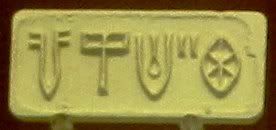 |
| (Lothal, according to the ASI) |
4000 year back, in Lothal, Gujarat, a merchant walked from his home in the lower town towards the wharf. As he walked past the bead factory, he saw the artisans already at work there; some of these beads were in demand in lands as far away as Mesopotamia. Crossing the public drain and the acropolis he reached the wharf. There were quite a few ships waiting to carry goods to Dilmun, Ur, and Lagash.
He glanced to his left, in the direction of the worker’s barracks, located at the far end of the wharf and quickly walked to the opposite end – towards the warehouse. All the goods were bundled and tied as expected. As he walked to the first bundle, one of his workers put some wet clay on the rope. He took a rectangular seal from the folds of his dress and pressed it hard on the clay. Satisfied with the impression, he moved on to the next bundle. When the recipient got the shipment, he would know exactly what is contained.
There are good reasons to believe that such a scenario could have happened. One probable use of Indus seals was in economic activity; the seals found in Lothal had impressions of a coarse cloth on their reverse and sometimes several seals were used to mark the goods. Besides this, there is enough evidence of trade relations between the Harappans and Mesopotamia going far back to the time of Sargon of Akkad (2270 – 2215 B.C.E) and even before that to 4000 B.C.E with the find of Baluchistan cotton in Jordan.
Seals
In 1875, Major-General Clark, who was the Commissioner of Awadh, discovered the first seal which had the engraving of a hump-less bull and six signs above it in Harappa[3]. 134 years later we don’t know what is written on those seals; there are many decipherments, but no consensus. While papers are coming out, applying various statistical methods to find out if the Indus seals encode a linguistic system, there is another debate over if these small palm size steatite seals with random looking inscriptions represent Indo-European, proto-Dravidian, Munda or some other language.
Why is decoding the Indus script and language so hard when Egyptian hieroglyphics, Linear B and cuneiform have been deciphered? In the case of Egyptian hieroglyphics and cuneiform there was bi-lingual encoding, like the Rosetta stone, which helped. When it comes to the Indus, which is an unknown script representing an unknown language, we don’t have that luxury. Linear B was deciphered without bi-lingual text which gives hope, but then Indus seals are short. The average length of a seal is 5; the longest single sided inscription has seventeen signs. With such data, deciphering the seal is a hard task.
When it comes to the Indus seals we want answers to these questions:
- What is the script?
- What is the language?
- What is the subject matter?
- Were the Harappans Vedic people or Dravidians?

